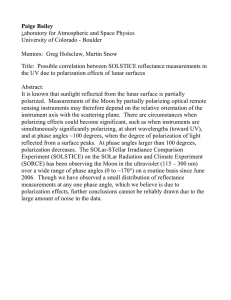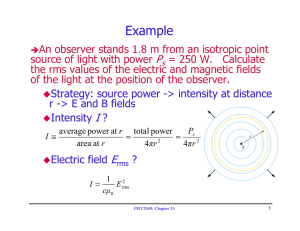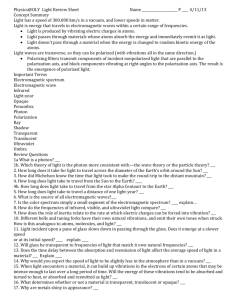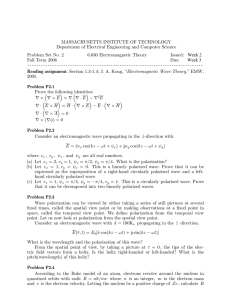Electromagnetic Waves
advertisement
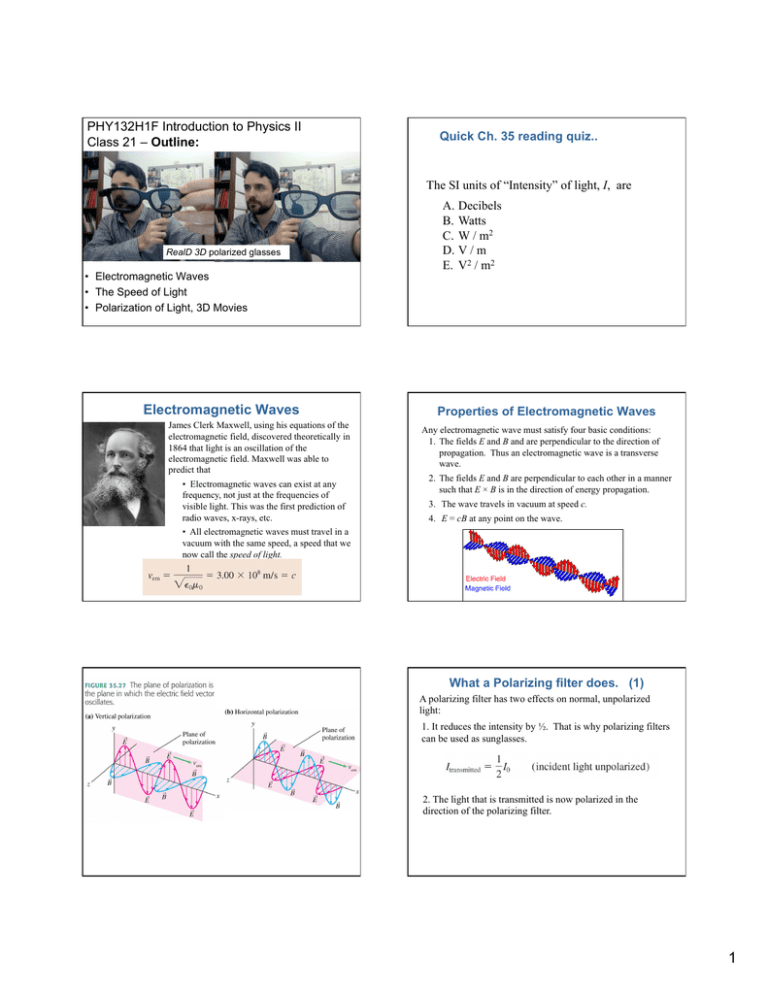
PHY132H1F Introduction to Physics II Class 21 – Outline: Quick Ch. 35 reading quiz.. The SI units of “Intensity” of light, I, are RealD 3D polarized glasses • Electromagnetic Waves • The Speed of Light • Polarization of Light, 3D Movies Electromagnetic Waves James Clerk Maxwell, using his equations of the electromagnetic field, discovered theoretically in 1864 that light is an oscillation of the electromagnetic field. Maxwell was able to predict that • Electromagnetic waves can exist at any frequency, not just at the frequencies of visible light. This was the first prediction of radio waves, x-rays, etc. A. Decibels B. Watts C. W / m2 D. V / m E. V2 / m2 Properties of Electromagnetic Waves Any electromagnetic wave must satisfy four basic conditions: 1. The fields E and B and are perpendicular to the direction of propagation. Thus an electromagnetic wave is a transverse wave. 2. The fields E and B are perpendicular to each other in a manner such that E × B is in the direction of energy propagation. 3. The wave travels in vacuum at speed c. 4. E = cB at any point on the wave. • All electromagnetic waves must travel in a vacuum with the same speed, a speed that we now call the speed of light. Electric Field Magnetic Field What a Polarizing filter does. (1) A polarizing filter has two effects on normal, unpolarized light: 1. It reduces the intensity by ½. That is why polarizing filters can be used as sunglasses. 2. The light that is transmitted is now polarized in the direction of the polarizing filter. 1 A Horizontal Polarizing Filter. What a Polarizing filter does. (2) If the light that strikes the polarizing filter is already polarized, then the amount of light transmitted depends on the angle between the polarization of the incident light, and the polarization axis of the filter. In any case, the light that is transmitted by a polarizing filter is always polarized in the direction of the polarizing filter. Example: the angle between the incident light polarization (Efield oscillations) and the polarizing filter axis is 90 degrees. Result: No light transmitted. Example: the angle between the incident light polarization (Efield oscillations) and the polarizing filter axis is 0 degrees (parallel). Result: All light transmitted! (100%) In Class Discussion Quiz 1 / 4 Polarization can be a property of A. Transverse waves B. Longitudinal waves C. Both In Class Discussion Quiz 2 / 4 The glare seen from water is mostly A. Horizontally polarized B. Vertically polarized C. Non-polarized In Class Discussion Quiz 3 / 4 Light will not pass through a polarizing filter if its polarization axis is A. Parallel to the filter polarization B. Perpendicular to the filter polarization C. 45 degrees to the filter polarization 2 In Class Discussion Quiz 4 / 4 The polarization axes of ordinary polarized sunglasses are A. Vertical B. Horizontal C. At right angles to each other • Binocular vision allows us to tell relative distances to objects within about 6 m. • 3-D movies are filmed / computer-generated from two sideby-side perspectives. • In the theatre, two synchronized projectors project two respective views onto the screen, each with a different polarization. • The glasses allow only one of the images into each eye. Circular Polarization Malus’s Law RealD 3D glasses, popular in movies in 2010, use Left and Right circular polarized light. right-hand circular polarization 3-D Movies left-hand circular polarization Suppose a polarized light wave of intensity I0 approaches a polarizing filter. θ is the angle between the incident plane of polarization and the polarizer axis. The transmitted intensity is given by Malus’s Law: electric field electric field Properties of Electromagnetic Waves The energy flow of an electromagnetic wave is described by the Poynting vector defined as Radiation Pressure It’s interesting to consider the force of an electromagnetic wave exerted on an object per unit area, which is called the radiation pressure prad. The radiation pressure on an object that absorbs all the light is The units of S are [Watts / m2]. The magnitude of the Poynting vector is The intensity of an electromagnetic wave whose electric field amplitude is E0 is where I is the intensity of the light wave. The subscript on prad is important in this context to distinguish the radiation pressure from the momentum p. 3 Joke: Why Did the Chicken Cross the Road? Aristotle (330 BC): “Because it is the nature of chickens to cross roads.” Newton (1687): “Because there is no external net force causing the chicken’s velocity across the road to change.” Einstein (1905): “Is the chicken crossing the road, or is the road moving under the chicken?” Before Next Class: • Please read the first 6 sections of Chapter 37, on Einstein’s Theory of Relativity. • You must submit an electronic version of your measurement project on Turnitin.com by Wednesday. • We would also very much appreciate a paper copy to be handed to your TA in practicals on Friday. It should be identical to what you sent to turnitin.com. We will mark the paper version, but the turnitin.com version is considered your “official” version if there is any difference. See you Wednesday! 4

